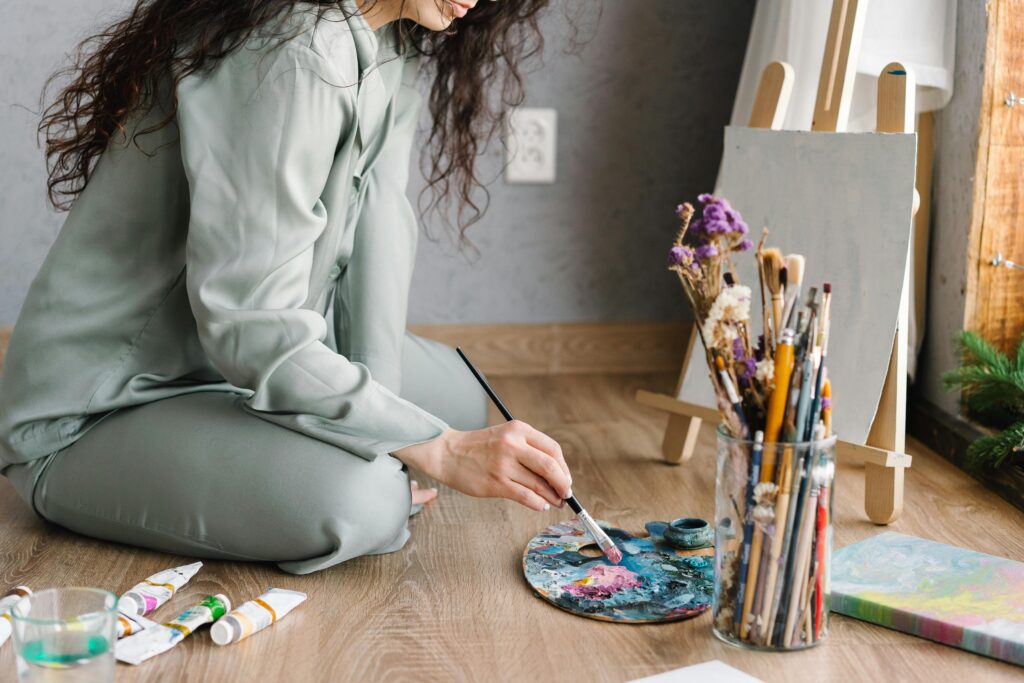Art therapy is a powerful, creative approach to healing that combines therapeutic practices with artistic expression. Through drawing, painting, sculpting, or other forms of art, individuals can explore complex emotions, process past trauma, and express themselves in a safe, non-verbal way.
Unlike traditional talk therapy, art therapy offers a gentler path to communication—allowing individuals to reveal what they’re feeling without having to find the perfect words. This can make it easier to confront painful topics, reduce anxiety, and build greater self-awareness. Because emotional pain and unresolved trauma often lie at the root of substance use, creative therapies like this can play a crucial role in long-term recovery.
At Pioneer Behavioral Health, we incorporate art therapy into our treatment programs as a unique and effective method for emotional healing and personal growth.
What is Art Therapy?

Art therapy uses creative expression as a therapeutic tool, helping individuals communicate what they may not be able to say out loud. Although humans have used art for self-expression for centuries, it wasn’t formally recognized as a therapeutic practice until English artist Adrian Hill discovered its healing benefits while recovering from tuberculosis in the 1940s.
Today, art therapy is widely used to treat a range of conditions, including anxiety, depression, PTSD, eating disorders, and addiction. According to the American Art Therapy Association (AATA), art therapy supports healing by helping individuals confront trauma, manage emotions, and navigate life’s challenges.
And no, you don’t need to be an artist. What matters most is your willingness to engage in the creative process and explore the emotions that surface.
Types of Art Therapy
Art therapy takes many forms, giving participants the freedom to choose the medium that best suits their comfort and style. Common examples include:
- Visual Arts: Painting, drawing, coloring, sculpting, woodcarving
- Mixed Media: Collages, scrapbooking, digital artwork
- Expressive Arts: Poetry, creative writing, music, dance, acting
Whether creating abstract art or a detailed self-portrait, the goal is the same: to explore, release, and better understand your emotions.
What to Expect in an Art Therapy Session
A typical art therapy session begins with a conversation. You’ll meet with your therapist to talk about your goals, your past experiences, and what you hope to achieve through the process.
Once you’re comfortable, the creative work begins. You may work individually or as part of a group, with your therapist offering guidance and support as emotions arise. After completing a piece, you’ll reflect on what you created, discussing thoughts and feelings that surfaced during the process. Sometimes, the therapist may help interpret certain elements of your artwork to reveal deeper insights.
Over time, this process promotes healing by helping you work through buried emotions, build self-understanding, and develop healthier coping strategies.
Why Art Therapy is So Effective in Addiction Recovery
1. Safely Exploring Difficult Emotions
Talking about trauma, loss, or shame can be overwhelming—especially in early recovery. Art therapy gives individuals a non-threatening way to express these emotions. Instead of being put on the spot, you focus on your artwork, which becomes the gateway to deeper conversations and healing.
2. Promoting Self-Reflection and Emotional Honesty
Art can act as a mirror, reflecting parts of yourself that are difficult to confront. Self-portraits and visual timelines can help reveal how addiction has affected your identity and life. This kind of reflection can be the key to breaking through denial and fully embracing the recovery journey.
3. Managing Cravings and Boosting Mood
Cravings often occur because the brain is seeking a dopamine rush. Creative activities naturally stimulate dopamine production, helping to satisfy this need in a healthy way. The sense of accomplishment you feel after creating something meaningful also boosts mood and motivation—reducing the urge to use substances.
4. Rebuilding Self-Worth and Confidence
Recovery can be filled with moments of doubt. Art therapy helps rebuild confidence by reminding you of your capacity to create, express, and grow. Each completed artwork is a visual reminder of your resilience and creativity. As skills develop, so does your belief in your ability to succeed in recovery and in life.
Get Art Therapy in Longmeadow, MA

At Pioneer Behavioral Health, we take a whole-person approach to healing. That means addressing not just the physical side of addiction, but the emotional and psychological layers as well. In our outpatient programs, art therapy is used alongside evidence-based treatments like individual therapy, group counseling, 12-step meetings, and trauma-informed care.
Through painting, sculpting, writing, or other creative outlets, our clients gain new tools for expressing their feelings, setting healthy goals, and building a strong sense of identity. Art therapy also helps individuals reconnect with parts of themselves that may have been lost to addiction—unlocking inner strength, resilience, and purpose.
Whether you’re creating a piece that reflects your journey or simply using colors to express an emotion, art therapy provides a healing space where recovery can truly begin.
If you’re ready to experience the healing power of art therapy, Pioneer Behavioral Health is here to walk beside you.
Reach out to us today to learn more about how our outpatient programs combine traditional therapies with holistic practices like art therapy. We’re available 24/7 and ready to support you every step of the way.


